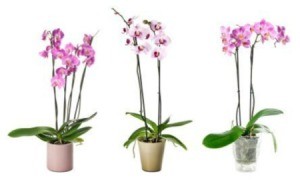 Orchids are available from many sources, but most are purchased from flower shops, garden centers, or from orchid nurseries either in person, or online. If you are new to the world of growing orchids, here are some tips for buying them.
Orchids are available from many sources, but most are purchased from flower shops, garden centers, or from orchid nurseries either in person, or online. If you are new to the world of growing orchids, here are some tips for buying them.
Good Orchids for Beginners
If you are new to growing orchids, it's a good idea to start with the more easy-to-grow orchids before graduating to orchids that have more demanding care requirements. You'll find "beginner" orchids readily available from local retailers. These orchids are often the types you see offered at discount stores, home centers, or even grocery stores. Despite being subjected to some fairly difficult conditions (transport and distribution) they are usually sold in flower, or at least in spike (buds about to unfurl).
Types of "Beginner" Orchids
- Brassavola
- Brassia
- Catteya
- Cymbidium
- Encyclia
- Epidendrum
- Oncidium
- Paphiopedilium (some)
- Phalaenopsis
Buying a Healthy Plant
The first step in assessing the plant's overall health is to look at its leaves. They should be firm and unbroken, although a slight amount of damage is usually no cause for concern. Next, inspect any visible roots. Look for a healthy white color with greenish tips. Finally, peek though the pot's drainage holes to make sure the roots don't look slimy or rotted.
Hopefully the orchid you select will also have at least one or two flowers open so you can see blooms. Do you like the color and form? With the exception of some slight variations in size and color intensity, you can expect the plant to always produce flowers like the ones you see.
Tips for Shopping Mail-Order Catalogs
- If you are new to shopping for orchids from an online or mail-order catalog, you may feel like you need a decoder to decipher the plant listings. Ideally, the catalog will feature a picture of the orchid's appearance as well as listing the plant's name (and its parental cross if it is a hybrid), growing requirements, the size of the plant (or pot), what stage of growth it is in, the price of the plant, and shipping information. In the case of hybrid orchids that have never bloomed, catalogue listings are a bit different. In terms of appearance, the listings may only offer a description of how the breeder predicts (or hopes) the plants will turn out.
- Size is an important factor when determining plant maturity, care requirements, and price. When an orchid is described as being of "blooming size" it generally means the plant will bloom within a year of purchase (if given the proper care). Beginners are encouraged to purchase blooming-size plants. These usually come in pots 4-inches across or larger. Later, as you gain more experience, you may want to try growing less-expensive, immature plants.
- Many nurseries offer orchid-of-the month programs that feature selections based on your level of experience and your growing conditions. These programs are a great way to get your feet wet collecting orchids and a good way to gain experience without obtaining too many different plants all at once.
Caring for New Arrivals
Depending on the grower, orchids are usually shipped one of two ways-bare root or potted. There are two main advantages to buying a bare root orchid plant-reduced shipping costs and the ability to choose your own growing medium and containers. When you receive a bare-root plant, inspect the leaves and roots, cutting off any damaged portions with a sharp, sterile knife. Then pot it and treat it as you would any other newly potted plant.
The advantage to buying a potted orchid is that it arrives ready to go. Potted orchids are usually allowed to dry out before they are packed and shipped to prevent rotting while in the box. When you receive one, inspect the leaves carefully and cut off any damaged parts, then give the plant a thorough watering.
Finding Bargains
Orchid societies: If there is an orchid society in your area, consider joining it. Attending meetings will afford you the opportunity to meet new people and increase your knowledge. Plants (divisions, seedlings, or offshoots) are often traded among members or offered by local growers at discounted prices.
Plant shows: Orchid shows can also be a good source for finding bargain plants. Most shows have vender areas where growers and exhibitors can offer their plants for sale. To find the best bargains look for bare-root orchids or recently potted divisions.
 Orchids are available from many sources, but most are purchased from flower shops, garden centers, or from orchid nurseries either in person, or online. If you are new to the world of growing orchids, here are some tips for buying them.
Orchids are available from many sources, but most are purchased from flower shops, garden centers, or from orchid nurseries either in person, or online. If you are new to the world of growing orchids, here are some tips for buying them.